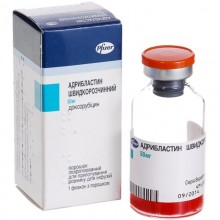



 Secure and encrypted payment processing
Secure and encrypted payment processing We ship to over 40 countries including the USA, UK, Europe, Australia and Japan
We ship to over 40 countries including the USA, UK, Europe, Australia and Japan Guaranteed refund or reship if you haven't received your order
Guaranteed refund or reship if you haven't received your orderdoxorubicin is an antitumor agent. tumor cells die, probably due to the effect of the drug on the synthesis of nucleic acids, although the exact mechanism of action has not been fully elucidated. the following mechanism of action is assumed: dna intercalation (which inhibits the synthesis of dna, rna and proteins), the formation of highly reactive free radicals and superoxides, chelation of divalent cations, inhibition of na / k-phase and the binding of doxorubicin to certain components of the cell membrane (in particular, membrane lipids, spectrin and cardiolipin). the highest concentrations of the drug observed in the lungs, liver, spleen, kidneys, heart, small intestine and bone marrow. doxorubicin does not cross the GEB - blood-brain barrier.
Pharmacokinetics After iv administration, the curve for eliminating doxorubicin from blood plasma is three-phase with a half-life of 12 minutes, 3.3 hours and 30 hours. Relatively long terminal T½ doxorubicin reflects its distribution in the deep compartment of tissues. Only about 33–50% of a drug with a fluorescent or tritium label (or decay products) were respectively detected in urine, bile, and feces within 5 days after administration. The rest of doxorubicin and breakdown products, obviously, remain in the tissues of the body for a long time.
In patients with cancer, doxorubicin is restored to adriamycin, an active cytotoxic compound. Such recovery is obviously catalyzed by cytoplasmic NADP-dependent (NADP - nicotinamide adenine dinucleotide phosphate) aldoketoreductases, which are present in all tissues and play an important role in determining the overall pharmacokinetics of doxorubicin.
The microsomal glycosidases present in most tissues break down doxorubicin and adriamycin into inactive aglycones. Aglycones can undergo O-demethylation followed by conjugation with sulfate or glucuronide ether and are excreted in the bile.
Treatment of a wide range of neoplastic diseases, including acute leukemia, lymphoma, malignant neoplasms in children and solid tumors in adults, in particular breast and lung carcinomas.
Adriblastin is administered intravenously and intravenously or as an intravesical instillation. doxorubicin should not be used as an antibacterial agent.
Intravesical administration of doxorubicin is an alternative route of administration in the treatment of superficial bladder cancer, including transitional cell carcinoma, papillary tumors of the bladder and carcinoma in situ, or in adjuvant therapy of low-grade bladder cancer of the That stage after transurethral resection.
Introduction The reconstituted solution is administered as an intravenous infusion with a free fluid flow for at least 3 minutes, but not more than 10 minutes. Typically, solutions of sodium chloride, 5% glucose or sodium chloride and glucose are used for dilution. Administration by jet injection is not recommended due to the risk of extravasation, which can occur even if there is an adequate reverse blood flow during aspiration through the needle.
The total dose of doxorubicin per cycle may be different, depending on the specific treatment regimen (for example, with monotherapy or in combination with other cytotoxic drugs) and indications.
The dose is usually calculated based on body surface area. With monotherapy, the recommended standard starting dose of doxorubicin per cycle for adults is 60–90 mg / m2 body surface area. The total initial dose per cycle can be administered 1 time, can be divided into 3 injections for 3 consecutive days, or administered 2 times - on the 1st and 8th day.Under the condition of normal recovery after the toxic effect of the drug (in particular, inhibition of bone marrow and stomatitis), each treatment course can be repeated every 3-4 weeks. If the drug is used in combination with other antitumor agents that may enhance toxic effects, a reduction in the dose of doxorubicin to 30–40 mg / m may be required.2 every 3 weeks
If the dose is calculated based on body weight, 1.2–2.4 mg / kg of the drug should be administered as a single dose every 3 weeks.
It is noted that with the administration of doxorubicin in a single dose every 3 weeks, the manifestations of adverse toxic effects, mucositis, are significantly reduced. However, some experts believe that the dose distribution for administration within 3 consecutive days (0.4–0.8 mg / kg or 20–25 mg / m2 daily) provides greater effectiveness, but at the expense of greater toxicity.
It has been demonstrated that weekly doxorubicin administration is as effective as 1 time every 3 weeks. The recommended dose is 20 mg / m2 1 time per week, although an objective reaction was noted at 6-12 mg / m2. With weekly use, cardiotoxicity is reduced.
Dose reduction may be required in patients previously treated with other cytotoxic drugs. A lower dose may also be required in children, obese patients, and the elderly.
Reducing the initial dose or increasing the intervals between cycles may be appropriate in patients who have had a hard time transferring previous courses of treatment, or in patients with neoplastic bone marrow infiltration (see SPECIAL INSTRUCTIONS).
Impaired liver function. In case of impaired liver function, the dose of doxorubicin should be reduced, as shown in the table:
| Plasma Bilirubin Level | Recommended dose |
| 1.2–3 mg / 100 ml
3 mg / 100 ml |
50% of the usual dose
25% of the usual dose |
Doxorubicin should not be used in patients with severely impaired liver function.
B / a introduction. B / a administration was used when trying to increase local activity at a low total dose and thus reduce overall toxicity. It should be noted that this technique is potentially very risky and can lead to extensive necrosis of perfused tissue if appropriate measures are not taken. Doses of the drug and inter